The 1930s were a decade of remarkable transformation, where fashion truly blossomed amidst global challenges. As the Great Depression loomed, designers responded with creativity and grace, offering styles that emphasized elegance and practicality. From Hollywood glamour to tailored sophistication, 1930s fashion left an indelible mark on the world, and its influence can still be seen today. Let’s dive into what made fashion from this era so iconic and enduring.
Key Trends of 1930s Fashion
The fashion landscape in the 1930s shifted to reflect the needs of the times. Practicality merged with flair as people sought to stay stylish on a budget.
1. Bias-cut Dresses
One of the standout trends was the bias-cut dress, made popular by designers like Madeleine Vionnet. These dresses clung beautifully to the body, emphasizing the natural curves of women and adding a soft, flowing elegance to any look.
2. Hollywood Glamour
Cinema had a profound influence on fashion during the 1930s. Stars like Jean Harlow and Bette Davis epitomized glamour, wearing slinky satin gowns and chic fur stoles. This decade saw the rise of evening wear with luxurious materials like silk, chiffon, and velvet.
3. Tailored Suits
Daywear took on a much more structured form. Women’s suits, often made from wool or tweed, became popular for their versatility. With broad shoulders and nipped waists, these suits showcased strength and femininity all at once.
4. Hats and Accessories
Hats were an essential part of any outfit in the 1930s. Whether it was a beret, cloche, or wide-brimmed hat, headwear added the finishing touch. Accessories like gloves, scarves, and handbags were equally important, each piece complementing the polished style of the time.
Fabric Choices and Silhouettes
The fabrics of the 1930s had a luxurious feel but were chosen carefully for practicality as well. Silk, velvet, and chiffon dominated evening wear, while cotton and wool made everyday outfits more accessible.
Fashion silhouettes in the 1930s evolved to elongate and slim the figure. Hemlines dropped, waists were accentuated, and skirts flowed gently to mid-calf. The fit-and-flare silhouette became a signature look, flattering women’s figures while maintaining modesty.
1930s Fashion Icons
The stars of the silver screen weren’t the only fashion icons of the 1930s. Designers such as Elsa Schiaparelli and Coco Chanel revolutionized the way women dressed during this era. Schiaparelli was known for her bold, artistic designs, often playing with colors and unconventional materials, while Chanel continued to perfect the timelessness of the little black dress.
The Role of Hollywood in Fashion
The influence of Hollywood can’t be overstated when discussing 1930s fashion. Movies were escapism, offering glamour and luxury that contrasted with the stark realities of life during the Great Depression. Film costumes became a way for people to dream, and many fashion trends of the decade can be traced back to the silver screen.
Key Features of Hollywood Fashion in the 1930s:
- Satin Gowns: Fluid and form-fitting, often bias-cut for maximum drape.
- Fur Stoles and Capes: Luxurious pieces that symbolized wealth and status.
- Dramatic Makeup: Thin, arched eyebrows, dark lips, and pale complexions added to the overall drama of the era’s look.
FAQs on 1930s Fashion
- What defined fashion in the 1930s?
Fashion in the 1930s was defined by the mix of practicality and elegance. Bias-cut dresses, tailored suits, and glamorous evening gowns were all staples of this era, influenced by both economic conditions and Hollywood. - What role did Hollywood play in 1930s fashion?
Hollywood played a huge role in shaping fashion during the 1930s. The glamorous styles worn by film stars were emulated by women everywhere, with satin gowns, furs, and chic accessories becoming part of the decade’s signature look. - What types of fabrics were popular in the 1930s?
Luxurious fabrics like silk, velvet, and chiffon were popular for evening wear, while cotton and wool were common in daywear. Practicality often guided the choice of fabrics during the Great Depression. - What was the silhouette of the 1930s?
The typical 1930s silhouette emphasized long, flowing lines. Women’s clothing was designed to elongate the figure, with bias-cut dresses and skirts that flared from the waist. Tailored suits featured broad shoulders and nipped-in waists.
Summary
The 1930s fashion era was a blend of sophistication, practicality, and Hollywood glamour. Designers responded to the global challenges of the time by creating looks that were both beautiful and functional. The trends that emerged during this decade—such as bias-cut dresses, tailored suits, and glamorous evening wear—have stood the test of time, continuing to inspire modern fashion. Whether influenced by the silver screen or by necessity, the style of the 1930s remains a testament to the creativity and resilience of the era.
Authoritative Links:
- www.vintagefashionguild.org/1930s-fashion
- www.historyextra.com/1930s-fashion
- www.fashionhistory.com/1930s-silhouette
